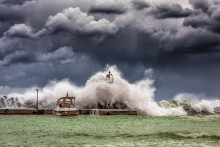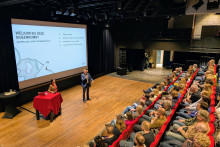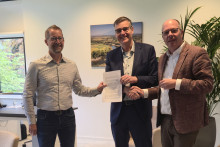Can you briefly summarize why the 1953 North Sea flood (Watersnoodramp) was so disastrous in the Netherlands?
Warmink: ‘It was a disaster that came fully unexpected. It was a sudden combination of a high spring tide and a large storm, which surprised everyone in the middle of the night seventy years ago. At that time, nobody expected that the dikes could break, but these sea defences failed due to the combination of wind, high tide, and low pressure.’
Is it possible that such a flood could happen again?
‘In 1953, flood protection policy was not well organized in the Netherlands. After the disaster, people realized how big of a problem this was. A huge operation – Delta Works - was initiated very quickly, and the Netherlands became a pioneer in water management and flood protection. There has been an enormous amount of research and development to make sure that such a flood would never happen again. Yet, in 1993 and 1995 the dikes nearly failed again in the Netherlands. Everyone focused on protecting the coast, but this time the threat didn’t come from the sea. It came from rivers. Once again, the flooding was sudden and unexpected. In 2021, we again thought that we had everything under control, but due to heavy rain, there were big floods in Limburg. We’ve been reacting to events that we expect, but disasters happen due to developments we don’t expect. We are trying to be more proactive nowadays, but you can’t ever rule out the possibility of a disaster.’
What type of impact did the disaster have on flood protection policy and dike development in the Netherlands?
‘We have done a lot of technological research into solutions to prevent floods and these solutions have been tested on a very large scale. Recently, however, we have realized that we also need nature-based solutions, not only technological developments. Only raising dikes is no longer an option given the challenges we are facing. It’s very costly, needs to be maintained and it increases the risk. Once you raise the dike, you also increase the height difference between the sea and the land. If there is a dike breach, the consequences are much greater.’
Do you see nature-based solutions as the future of dikes?
‘Yes, I’d say so. Nature-based solutions mean using natural processes to protect us against flooding. For example, we are working on so called living dikes, green dikes with wetlands in front of them that break the waves and buffer coast against storms. We are also researching biodiverse dikes, which have more biodiverse dike covers, not only grass. Other covers can better protect us against high water and are a lot stronger in withstanding droughts. This way we also make dikes more sustainable. However, we need the combination of both solutions: nature-based and technological. In some places you simply need to build higher dikes.’
Do you work on these solutions at the University of Twente?
‘Absolutely. We are now starting a big project on future flood risk management, which will look into how we can strengthen the flood protection. A new idea is to look at the whole water system and see how all its components – rivers, estuarine and coastal systems - work together. The previous approach was really focused on dikes. Now we want a more holistic and proactive approach to flood protection.’
What were the main lessons learnt from the North Sea flood of 1953?
‘The Netherlands now has the highest flood protection standards in the world. As a result of the 1953 disaster, people realized that flood protection was extremely important and needed attention. And this attention hasn’t disappeared since. The event raised awareness and resulted in a lot of knowledge that we now export all around the world. The 2005 floods in New Orleans were similar to the 1953 events, because they were very unexpected and happened in a place where flood protection was previously not high on the agenda. A huge reinforcement program was started immediately after – with the help of Dutch experts. Bring in the Dutch! Those were headlines in American newspapers at the time. We have never stopped working on the topic since 1953. The focus might have shifted, but the urgency has not.’







